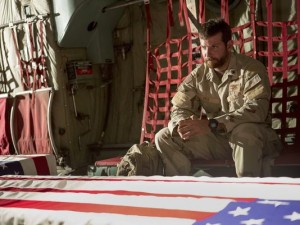
Bradley Cooper on portraying famed Navy SEAL Chris Kyle
In 2012, actor Bradley Cooper called up former Chief Special Warfare Operator (SEAL) Chris Kyle to discuss the movie he was developing based on Kyle’s memoir, “American Sniper.”
“I just thought I should get on the phone with him and let him know what I was willing to do for him, and to trust me,” said Cooper, who produced and starred in the new biopic, which has a scheduled national release on Jan. 16.
Months later, the film’s screenwriter called Cooper with tragic news.
“Never did I think on Feb. 2, 2013, I would get a call from Jason Hall that Chris was murdered,” Cooper said in a Dec. 19 phone interview. “So that sure changed everything.”
Kyle and a friend, Chad Littlefield, were shot to death on a Texas shooting range by Eddie Ray Routh, a Marine veteran whom they’d taken out to help work through his post-traumatic stress.
The film pressed on, though. Directed by Clint Eastwood, the story follows Kyle through his early days as a Texas rodeo cowboy, to his time at SEAL training in 1999 and on to his four deployments to Iraq, where he racked up what’s believed to be the most confirmed kills in U.S. military history as a sniper with SEAL Team Three.
Though some, such as Washington Post reporter Terrence McCoy, have questioned the accuracy of Kyle’s stories, Cooper said he focused on making a Global War on Terror film different from what’s already been done.
Kyle’s relationship with his wife, Taya, and his difficulties reintegrating after deployment feature heavily.
“There hasn’t been a character study of a soldier that’s gone through this war that I’ve seen on film,” he said. “I liked that idea, and I thought framing it as a Western would be very interesting.”
Questions and answers from Navy Times’ interview have been edited for brevity.
Q. How did Kyle’s death change the process?
A. It changed absolutely everything. The reason to make the movie changed, in a lot of ways. The expediency with which we filled our commitment changed. And that all happened, quite honestly, because [former director] Steven Spielberg felt the way we did — his story needs to be told now. It’s just too relevant.
Q. How did you learn about him?
A. Clint and I went to Midlothian, Texas, spending time with Taya and his kids, [his parents] Wayne and Deby, his brother Jeff and [his brother’s wife] Amy. The work that I did was all based on what Taya gave me, and also training with guys who had trained Chris on sniper rifles.
Q. Was there anything surprising about his life?
A. Everything was surprising, because I’m from Philadelphia and I’ve never been in the military. It was all new to me, and fascinating. Learning how to become proficient with the .338 and the .300 [Winchester Magnum], the Mk11 [Sniper Weapon System], shooting targets 600 feet away.
And breathing. I didn’t even know, really, how you pull a trigger on a weapon like that. It was amazing.
Q. How did you bulk up?
A. It was a heavily regulated regimen. We had three months. I had a goal of 30 pounds of muscle. Not bodybuilding, but to be like Chris. He was a very big, thick, strong man.
It was 6,000 calories a day. Wake up at 5 a.m., work out from 6 to 8:30. Dialect from 10 to 12. Two to 4:30 work out again. Then 6 to 8 dialect, and then sleep. I did that five days a week, with rifle training on weekends.
Q. How did you pick up his Texas accent?
A. I had so much access to Chris, based on interviews he’d done and video. Hours and hours of him talking. I had this huge document that I put on my iPhone and my iPad and I just had it on constantly. I had earbuds on that whole time, just listening to his voice, repeating what he would say.
Q. Did you stay in character throughout filming?
A. It wasn’t anything conscious. I wouldn’t say I stayed in character — he was inside me the whole time and I was in his voice the whole time. But if you said, “Bradley,” I would have turned around.
Q. Did you have any reservations about playing a controversial figure?
A. Despite what maybe people have said about him, if you watch what I’ve watched — very humble guy. And whenever people would talk about the number, he doesn’t really think about that.
He wished they’d record how many lives saved as opposed to killed. He didn’t understand why you would mark it up as confirmed kills instead of lives saved.
I never felt like I was playing anybody other than someone I admired. The whole thing about “The Legend” was a joke at first. And then it became a thing these guys put on because they knew he would hate it.
Q. You seem very conflicted in some scenes. Was that a conscious decision?
A. It’s for the audience to decide whether he’s conflicted about what he’s doing. He certainly says, at the end of the movie when he’s talking to the psychologist, the only thing that bothers him are the lives he couldn’t save.
I tend to not even comment on it, because that’s the beauty of making a movie, is that it’s for the audience to decide what’s going on in his head.
Q. Taya Kyle told Military Times that she felt like she was watching her husband on screen, not you. How does it feel to hear that?
A. It’s the best possible thing I could hear. What we wanted to do, as filmmakers, is make a movie that people can relate to if they’re soldiers, and if they aren’t, see it a way that they never did before.
And see what soldiers are like in today’s world, as opposed to what movies are like in Vietnam. A lot of movies have been more about the idea of the unit, like “Jarhead” or “Black Hawk Down.” But there’s something about making a character study that I love.
This character happens to be a real man. This is a movie that’s going to live with [their] children, his parents, forever. I felt a massive responsibility to do right by them. The fact that they feel that way means the world to me.
Q. Did you take any artistic liberties with the story?
A. Of course, but at the same time, when you’re telling a story, you have to make changes to serve the story and the character. We changed chronology and took liberties because it’s a story, it’s a movie.
And in terms of the other guys who were cast from SEAL Team Three, I had the benefit of a lot of time to prep – they had like two weeks.
The one thing that I could control is, I wanted it to look like this guy that you’re watching is very familiar and dexterous with his weapons, and I felt successful with that.
Q. In several scenes, he’s making calls to his wife while on a mission. Was that accurate?
A. Oh yeah, that was accurate. Well, first of all, SEALs have access to [satellite] phones. When he made chief, he got the sat phone. The four bars of service, we took a liberty with, just because otherwise it would have been like a 10-minute scene. So we did take a liberty with how good the service was.
Q. What kind of feedback are you expecting from audiences, especially troops?
A. I just go into it ready to talk about it. I have no desire to make art in a bubble, so I can’t wait for soldiers and vets to see it. My hope to God is that they feel like it’s authentic to a degree that they might not feel so alone anymore, and their story’s getting out.
Source: Marine Times





Leave a Reply